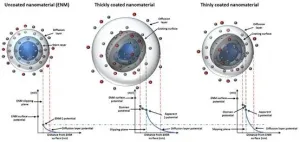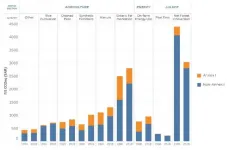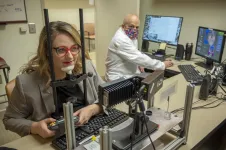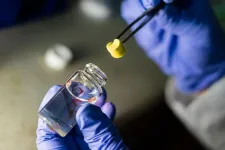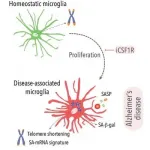(Press-News.org) Researchers have developed a 'library of properties' to help identify the environmental impact of nanomaterials faster and more cost effectively.
Whilst nanomaterials have benefited a wide range of industries and revolutionised everyday life, there are concerns over potential adverse effects - including toxic effects following accumulation in different organs and indirect effects from transport of co-pollutants.
The European Union H2020-funded NanoSolveIT project is developing a ground-breaking computer-based Integrated Approach to Testing and Assessment (IATA) for the environmental health and safety of nanomaterials.
Over the last two years, researchers from the University of Birmingham have worked with experts at NovaMechanics, in Nicosia, Cyprus to develop a decision support system in the form of both stand-alone open software and a Cloud platform.
The team has developed a freely available cloud library containing full physicochemical characterisation of 69 nanomaterials, plus calculated molecular descriptors to increase the value of the available information, details of which are published in NanoImpact.
Professor Iseult Lynch, from the University of Birmingham commented: "One of the limitations to widespread application of computer-based approaches is the lack of large well-organised high-quality datasets, or of data with adequate metadata that will allow dataset interoperability and their combination to create larger datasets."
"Making the library of calculated and experimental descriptors available to the community, along with the detailed description of how they were calculated is a key first step towards filling this datagap."
Development of the cloud-based nanomaterials library is the fifth freely available web-based application that the project has delivered.
Antreas Afantitis, from NovaMechanics, commented: "Over the last two years, this project has already presented some very impressive results with more than 30 publications, making NanoSolveIT one of the most active projects in the nanomaterials safety and informatics space."
Concerns about nanomaterials are also arising as risk assessment is lagging behind product development, mainly because current approaches to assessing exposure, hazard and risk are expensive and time-consuming, and frequently involve testing in animal models. The NanoSolveIT project aspires to address these challenges.
The latest development aims to enrich our knowledge of nanomaterials properties and the link from property to (cytotoxic) effect. The enriched dataset contains over 70 descriptors per nanomaterial.
The dataset was used to develop a computer-based workflow to predict nanomaterials' effective surface charge (zeta-potential) based on a set of descriptors that can be used to help design and produce safer and more functional nanomaterials.
The resulting predictive read-across model has been made publicly and freely available as a web service through the Horizon 2020 (H2020) NanoCommons project (http://enaloscloud.novamechanics.com/nanocommons/mszeta/ ) and via the H2020 NanoSolveIT Cloud Platform (https://mszeta.cloud.nanosolveit.eu/ ) to ensure accessibility to the community and interested stakeholders.
In addition, the full data set, ready for further computational modeling, is available through the NanoPharos database, as the project consortium supports the FAIR data principles - committing to making its data Findable, Accessible, Interoperable and Re-usable.
INFORMATION:
For more information please contact Tony Moran, International Communications Manager on +44 (0)782 783 2312. For out-of-hours enquiries, please call +44 (0) 7789 921 165.
Notes for editors
The University of Birmingham is ranked amongst the world's top 100 institutions, its work brings people from across the world to Birmingham, including researchers and teachers and more than 6,500 international students from over 150 countries.
'Computational enrichment of physicochemical data for the development of a ζ-potential read-across predictive model with Isalos Analytics Platform' - Anastasios G.Papadiamantis, Antreas Afantitis, Andreas Tsoumanis, Eugenia Valsami-Jones, Iseult Lynch and Georgia Melagraki is published in NanoImpact.
A new global analysis says that greenhouse-gas emissions from food systems have long been systematically underestimated--and points to major opportunities to cut them. The authors estimate that activities connected to food production and consumption produced the equivalent of 16 billion metric tons of carbon dioxide in 2018--one third of the human-produced total, and an 8 percent increase since 1990. A companion policy paper highlights the need to integrate research with efforts to reduce emissions. The papers, developed jointly by the UN Food and Agriculture Organization, NASA, New York University and experts at Columbia University, are part of a special issue of Environmental Research Letters on sustainable food systems.
The Center on Global Energy ...
Stereotypes are knowledge structures integrated in our world representation, which have an influence on our decisions and which are hard to change. A team from the Faculty of Psychology of the University of Barcelona (UB) and the Bellvitge Biomedical Research Institute (IDIBELL), in collaboration with the Èpica Foundation - La Fura dels Baus analysed how a performing experience could have a positive impact in reducing the population's bias against physical illnesses. This performing experience is a pioneer one for it combines scientific training and theatre performance in the same working platform.
The study, published in the journal Frontiers in Psychology, shows that the participation ...
After looking for just one-twentieth of a second, experts in camouflage breaking can accurately detect not only that something is hidden in a scene, but precisely identify the camouflaged target, a skill set that can mean the difference between life and death in warfare and the wild, investigators report.
They can actually identify a camouflaged target as fast and as well as individuals identifying far more obvious "pop-out" targets, similar to the concept used at a shooting range, but in this case using easy-to-spot scenarios like a black O-shaped target among a crowd of black C shapes.
In fact, the relatively rapid method for training civilian novices to become expert camouflage breakers developed by Medical College of Georgia neuroscientist ...
Medics training to be GPs reported positive improvement in burnout and resilience after completing a mindfulness course specially designed for doctors
The participants in the study by Warwick Medical School also saw improvements in their wellbeing and stress
By improving the mental wellbeing of trainees the researchers hope to better prepare them for the challenges of general practice and the impact of Covid-19 on the profession
Supports the wider adoption of mindfulness in medical training and the need for larger studies
Medics training to become general practitioners reported a significant positive improvement in their mental wellbeing after participating in a specially-designed mindfulness programme, a study from University of Warwick researchers ...
HOUSTON - (June 8, 2021) - A simple chemical process developed at Rice University creates light and highly absorbent aerogels that can take a beating.
Covalent organic frameworks (COFs), crystal structures with strong molecular bonds, can form a porous aerogel for use as a custom membrane in batteries or other devices or as an absorbent to remove pollutants from the environment.
Conventional COFs are usually powders. Chemical and biomolecular engineer Rafael Verduzco, lead authors and Rice graduate students Dongyang Zhu and Yifan Zhu and their colleagues at Rice's Brown School of Engineering discovered a way to synthesize COF aerogels that can be made in any form ...
Listed by the World Health Organization among the ten leading causes of medical disability worldwide, the severity of obsessive-compulsive disorder (OCD) is at a level on par with cancer. This prevalent disorder is characterized by highly distressing intrusive thoughts and repeated compulsive behaviours such as washing or checking.
"Inadequately treated OCD can rapidly deteriorate to disability for many persons and can negatively impact every sphere of life including school or work, basic self-care and care of children, and psychosocial functioning," says clinical psychologist and internationally renowned expert in OCD and related disorders Dr. Debbie Sookman, who is an Associate Professor in the Department of Psychiatry ...
The promotion and marketing of unproven stem cell therapies is a global problem that needs a global solution, say experts in a perspective published June 8 in the journal Stem Cell Reports. The authors of the paper call for the World Health Organization (WHO) to establish an advisory committee on regenerative medicine to tackle this issue and provide guidance for countries around the world.
"The field of regenerative medicine, which entails the manipulation of cells and tissues to obtain therapeutic properties, has been hailed as the most promising research field in modern medicine," says senior author Mohamed Abou-el-Enein, the executive director of the joint University of Southern California/Children's Hospital of Los Angeles Cell Therapy Program. ...
A new study has pinpointed a small group of cells in the brain which could be crucial to understanding how Alzheimer's disease begins and how to slow its progression. This discovery could help research into treatment for the disease by focusing on this key group of cells in the brain.
Alzheimer's disease is the most common type of dementia, affecting between 50 and 75 per cent of those diagnosed. There are currently around 850,000 people with dementia in the UK. This is projected to rise to 1.6 million by 2040.
"Alzheimer's disease evolves over decades but we currently lack an understanding of the events that take place in the early stages," explained Dr Diego Gomez-Nicola of the University of Southampton ...
MELVILLE, N.Y., June 8, 2021 -- Variations in children's speech has traditionally been attributed to developmental delays. Recent work suggests the reasons for variability are not so clear, and an immediate call for treatment may need to be reconsidered.
During the 180th Meeting of the Acoustical Society of America, which will be held virtually June 8-10, Margaret Cychosz, from the University of Maryland, will discuss the need to better understand these variations. Her presentation, "Reconsidering variability in child speech production," will take place ...
Neural replay during waking rest may contribute to memory consolidation of action sequences in humans, according to a study published June 8 in the journal Cell Reports. Brain imaging results revealed fast, repeated reactivation of a neural network representing a behavioral sequence that people were learning--approximately 20 times the speed of the new memory--especially while they were taking breaks from practice.
"This is the first demonstration of wakeful neural replay of a newly learned skill elicited by practice in humans," says senior study author Leonardo G. Cohen (@LeonardoGCohen) ...
